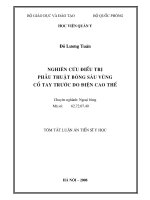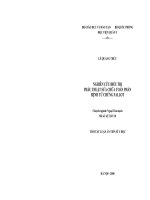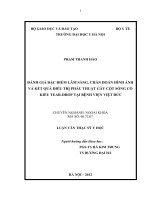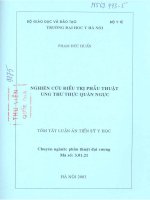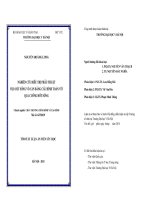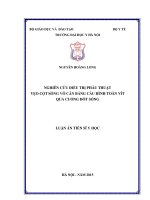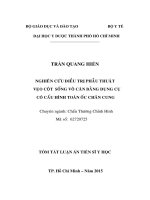Nghiên cứu điều trị phẫu thuật lao cột sống cổ qua đường mổ cổ trước tt tiêng anh
Bạn đang xem bản rút gọn của tài liệu. Xem và tải ngay bản đầy đủ của tài liệu tại đây (149.07 KB, 28 trang )
MINISTRY OF EDUCATION
MINISTRY OF HEALTH
AND TRAINING
HANOI MEDICAL UNIVERSITY
NGUYEN XUAN DIEN
RESEARCH ON TREATMENT OF ANTERIOR
CERVICAL SPINE TUBERCULOSIS SURGERY
Major : Orthopedics and Plastic
ID
: 62720129
PH.D. THESIS SUMMARY
HANOI - 2018
THE THESIS WAS FULFILLED AT
HANOI MEDICAL UNIVERSITY
Principal Supervisors:
Assoc.Prof. Nguyen Cong To
1st Peer-reviewer: Assoc.Prof. Pham Dang Ninh
2nd Peer-reviewer: Assoc.Prof. Nguyen Le Bao Tien
3nd Peer-reviewer: Assoc.Prof. Kieu Dinh Hung
Ph.D. Thesis will be evaluated by the Hanoi medical University
Thesis Board.
At
,
2019.
The thesis can be found at:
- National Library
- Hanoi medical University Library
LIST OF RESEARCH WORKS PUBLISHED RELATED
TO THE THESIS
1.
Nguyen Xuan Dien, Nguyen Cong To, Khuong Van Duy
(2018), “Features of cervical spine deformity and
anatomical lesions on imaging in patients with cervical
tuberculosis”,Viet Nam medical Journal, Issue 473, pages
2.
75 - 80, N0 1 and 2 December - 2018.
Nguyen Xuan Dien, Nguyen Cong To, Khuong Van Duy
(2018), “Evaluate the result of anterior cervical
tuberculous surgery treatment with only autograft crest or
expandable titanium cage”, Viet Nam Medical Journal,
Issue 473, pages 112-117, N0 1 and 2 December - 2018.
1
INTRODUCTION
Cervical spine tuberculosis (CST) is an uncommon disease
than lesions in thoracic and lumbar tuberculosis. But CST has usually
dangerous complications as spinal cord compression and cervical
deformity. Because of clinical features of this disease is poor, only
neck pain and restricted motion slightly in the first stage, so it was
missing diagnosed to bring about some serious complications. In
1779, Percival Pott firstly showed this disease with two main
symtoms as paraplegia and gibbus. And his name was named “Pott’s
disease”. Nowadays, they are a quite common in poor countries and
spends money very much for controlling disease. WHO 2017 forcasts
in Viet nam about 126 thounsands people have new tuberculosis per
year and 1000 new cases with osteoarthritis tuberculosis, especially
added HIV/AIDS had drug – resistant so treatment is more difficult.
Main deformity of CST is local kyphosis and kyphosis of
cervical lordosis C2-C7. There are rarely conferences on cervical
deformities due to tuberculosis in Viet Nam and there is hardly article
on CST.
Treatment of CST surgery was described first by Hodgson et al
in 1960 with basic standard are: anterior debridement, decompression
and autograft comcomitant with anti-tuberculosis drug. Result of this
procedure had 94% interbody fused, recovery of spinal cord deficit
95%. However, only autograft operation without spinal stable maybe
complication related to autograft as slip-out graft and postoperated
immobilization from 8 to 10 weeks. Especially, loss kyphotic
correction of cervical spine and no-prevention progressive of
kyphosis. Application plate titanium to reduce some complications
but kyphosis is still progressive postoperated. Non expandable
titanium cages (NETC) application help patients movement early but
there is dangerous cord compressed risk and not completely kyphotic
2
correct. Expandable titanium cages (ETC) was presented to good
result with kyphotic correct and prevented progressive kyphosis after
operating in the World for spinal degenerative, cancer, trauma and
first times in spinal tuberculosis. However, in Viet Nam, there is
hardly ever announced up to now. So we studied “Research on
treatment of anterior cervical spine tuberculosis surgery” to
objective:
1.
Evaluate deformity features and annatomical lesions of
cervical spine tuberculosis that anterior cervical surgery in
imaging procedures.
2.
Evaluate outcomes of anterior cervical spine tuberculosis
operation.
CURRENT CONCLUSION OF THE THESIS:
Studied prospectively 31 patients with anterior cervical
tuberculosis C2 to C7 operation. Timebound from January 1, 2015 to
September 30, 2017 in Viet Nam national lung hospital. This thesis is
clearly presented deformity, anatomical lesions of cervical spine due
to tuberculosis and the outcome of operated treatment with ETC
application.
ARRANEMENT OF THESIS
Thesis include 124 pages, four chapter in which overview 39
pages, materials and methods 18 pages; results 28 pages; discussion
34 pages; inclusion two pages; 48 tables; 7 charts; 33 pictures; 165
referrences; 9 vietnamese referrences and 156 English referrences;
and four recommandations.
CHAPTER 1: OVERVIEW
1.1. Current reality of tuberculosis in the World and Viet Nam
3
Estimating of WHO (2015), there is about 30 million new
people have tuberculosis per year, nowaday in the World, and about
1,8 million patients who died due to tuberculosis or related to
tuberculosis. In Viet Nam, there are about 126 thousand new cas per
year and almost one thousand have spinal tuberculosis. Almost spinal
tuberculosis is treated in non-operated. Only one part that has
complicated to indicate operation, about 40%. Belong to WHO 2017,
incident MDR-TB is increasing, in estimating about half million
cases per year. Especially, with HIV/AIDS because of higher 30
times than people without HIV. Spinal tuberculosis (SP) is very
difficult to treat due to intake in osteo tissue poorly. Although TB has
found for a long time ago by Robert Koch but this disease is still
problem of the World. In Viet Nam, there are not only no conferences
much on CST but also on treatment in operated very poor. On the
other hand, treatment of CST by complete anterior debride operation
and autograft was presented by Hodgson et al in 1960. This
procedure was a golden standard in operation. ETC was applied from
2003 in spinal tuberculosis and announced the first outcome safely,
effectively.
1.2. Features of clinic, image, diagnosis of cervical spinal
tuberculosis.
1.2.1. Character of anatomical lesions of CST by imaging
procedures.
The classic presentation of a patient with tuberculous
spondylitis includes spinal pain with manifestations of chronic
illness, such as weight loss, malaise, and intermittent fever. The
physical findings includes local tenderness, muscle spasm, and
restricted motion.
4
Although there are some presented symptoms as intermittent
fever, night sweats, loss of weight and appetite are specific to help
diagnosis but maybe these symptoms are noteable for patients going
to hospital. Clinical examination reveals tenterness of the affected
cervical segments and torticollis with associated paracervical muscle
spasm. Rarely, kyphotic deformity can be visualized with a palpable
knuckle or gibbus. In patients with cervical spinal cord compression
usually had been both upper and lower limbs deficit, maybe the
bowel and bladder dysfunction. Some clinical symptoms can help to
diagnose as neck pain (89-96%), restricted motion (95-100%),
neurological deficit (42,7 – 60%), bladder dysfunction (35%). (He et
al 2014; Qu-Jin Tao 2015; Yao et al 2017).
Anatomical lesions of cervical tuberculosis on imaging: Plain
Radiographs: in the very early stages, an increased of prevertebral
soft tissue shadow in the lateral radiographs without any bony
destruction may give the first indication of cervical TB. Normal
prevertebral soft tissue average in C2C3C4 is 5 – 7 mm and C5C6C7
is 18-20 mm (Penning L 1980). Changes of disk space narrowing and
blurring of end plates are visible only after a delay of 2 to 3 weeks
after the onset of infection. Radiologic evidence of bony destruction
is visible only after the lesion involves at least 50% of the vertebral
body. So based on the radiologic location of the tuberculous focus,
the lesion are classified as paradiskal, central, anterior, and
appendicular. Destruction of vertebral bodies in the subaxial cervical
spine results in a visible kyphotic deformity of the neck. A scalloped
appearance of the anterior margin of the vertebral bodies are infected,
thus skipping the intervening avascular disk by extension of infection
under the anterior longitudinal ligament. With progression of
deformity, the horizontal orientation of facet joints can quickly lead
5
to an unstable spine with subluxation or dislocation of facet joints.
Paravertebral calcifications of the abscess may rarely be observed in
chronic tubercular infections (Hodgson et al 1960; Hsu et al 1984;).
Computed Tomography: CT scan delineates th bony anatomy in
detail and shows the body destruction earlier than radiographs.
Although not as effective as MRI, CT scan can also identify the
extent of paravertebral abscess and soft tissue shadows to a certain
extent. Bilateral paravertebral abscess with calcifications and
fragmented osteolytic lesions with bony fragments within soft tissues
are pathognomonic of TB. CT scan, howerver, can provide excellent
details of the intergrity of the facet joints, pedicles, an laminae, which
are important in deciding the timing and nature of surgical
intervention. Axial CT cuts may miss early end plate destruction, and
multiplanar reconstructions are necessary to identify early lesions.
Contrast-enhanced CT scans better delineates the abscess walls and
infected granulation tissues. An important additional benefit of CT is
to identify the best location for CT-guided biopsy of the lesion
(McGahan 1985; Rauf 2015; Deng 2015). Magnetic Resonace
Imaging (MRI): MRI provide excellent soft tissue detail and is
highly sensitive in showing the early signal intensity changes in the
bone marrow and spinal cord so that appropriate treatment can be
instituted earlier. The earliest MRI changes include decreased signal
intensity in T1-weighted images and increased signal changes in T1weighted imanges as a result of bone marrow edema. Early reduction
in the height of the disk space is noted, although primary
involvement of the disks typically occurs late. Subligamentous
extension of infection to the adjacent vertebrae, mainly anteriorly, is
commonly observed. Abscess formation and collection and expansion
of granulation tissue adjacent to the vertebral body is highly
6
suggestive of spinal tuberculosis. MRI can also provide information
on the cause of the neurologic deficits. It can help identify
mechanical compression by the abscess, granulation tissue, bony
fragments, instability, and basilar impression. Intrinsic signal changes
within the spinal cord can be clearly visualized and help direct
appropriate treatment to improve the chances of neurologic recovery.
In particular, MRI can be useful in identifying TB in uncommon
sites, such as the cranniovertebral and cervicodorsal junction, where
other investigatory modalities can be difficult to interpret. Basilar
invagination, extent of paraspinal abscess, intradural disease, and
atlantoaxial dislocation with compression of the spinal cord are other
disorders that are often better delineated by MRI. The reported
sensitivity, specificity and accuracy of MRI in diagnosing TB are
96%, 92%, and 94%, respectively. A multilocular, calcified abscess in
the retropharynegeal and paraspinnal region with a thick, irregular
enhancing rim and associated bony fragmentation is characteeristic of
TB. Intraosseous, paravertebral, and epidural abscesses are clearly
visualized by fat-suppressed, gadolinium contrast – enhanced MRI.
Contrast-enhanced MRI can also help in differentiating granulation
tissue, which shows homogeneous enhancement, from abscess, which
has only rim enhancement. Progressive healing of the lesion and its
response to treatment can be documented by follow-up MRI scans.
Early signs of healing include increased signal intensity in T1weighted sequences resulting from the replacement of infected bone
by normal fatty marrow. However, the radiologic signs in MRI have a
lag period of 6 months when compared with clinical signs of healing.
MR angiography may be needed in patients with severe destruction
of the upper cervical spine to delineate the vertebral arteries before
7
surgical intervention (Modic 1985; Desai 1994; Currie 2011; Jain
2012; Maurya 2018).
1.2.2.
Diagnosis of cervical spinal tuberculosis
To diagnose exactly spinal TB needs Mycobacteria
tuberculosis evidence by caseous lesion culture or GeneXpert or
Haine from biopsy tissue on CT scan or operation. By clinical
practicing has not done easily this because TB culture needs 2-4
weeks give us result; AFB smear is usually negative and cervical
biopsy in early stage is very difficult to result exactly. When TB
cervical has presented typical clinic and image, diagnosing easyly. So
we can base on typical clinic and image to diagnose and treat.
Clinical presentations such neck pain, restricted motion, muscle
spasm, neurological deficits, bladder dysfunction, deformity of
cervical spine. Imaging as body destruction, kyphosis, narrowing
space, paravertebral caseous lesions or abscess, fragmented bony in
abscess or caseous lesion.
1.3. Classification of Spinal TB
There are many classified spinal TB that were announced in
the World but 4 types classification usually used commonly.
In 1967, Hodgson et al classified 2-types spinal TB was active
within 2 first years of disease and bony healing after 2 years disease.
This classification can not treat early and time waiting too long.
In 1985, Kumar et al introduced a 4-point classification for
posterior spinal TB based on site of involvement and stages of the
disease. One of the most important limitations attrubuted to this
classification system was only including posterior spinal TB which is
relatively rare.
8
In 2001, Mehta and Bhojraj announced a new classification
system for spinal TB using MRI fingdings. They divided patients into
4 groups according to the employed surgical technique. This
classification only categorizes thoracic lesions which is the most
important limitation of this system.
In 2008, Oguz et al developed a new classification system in
which spinal TB is classified into three main types, with type I lesion
being subdivided into two subtypes. With IA-type only managed in
drug and not operate. This classification was applied commonly, it
has no special focus on posterior lesions and therefore, this can be
considered as the main limitation of this classification system.
1.4. Deformity of cervical spinal tuberculosis
Evaluating deformity of cervical spine is very difficult because
we have to base on a lot of factors. In cervical spinal TB, main
deformity is local kyphosis because normal Cobb of cervical spine is
negative number. Kyphosis is Cobb more than 00 . And cervical
lordosis is also normal negative, when we measure Cobb is over 0 0
C2-C7 is called kyphosis. Normal C2-C7 is under -10 0 ; when is -100
to 00 as plain Cobb (Lee et al 2017).
1.5. Treatment of non-operation of spinal TB
Spinal tuberculosis is caused by Mycobacteria tuberculosis and
an infected disease so main treatment of this disease is
antituberculosis-drugs and complex at least 4 type of drugs. Adequate
early pharmacological treatment can prevent severe complications.
Combination of rifampicin, isoniazid, ethambutol, and pyrazinamid
for two months followed by combination of rifampicin and isoniazid
for a total period of 6, 9, 12 or 18 months is the most frequent
protocol used for treatment of spinal TB. Early diagnosis of spinal
TB is very important as adequate early pharmacological treatment
9
can prevent severe complications. The proposed regimen of World
Health Organization (WHO) with total duration of 6 months consists
of primary treatment with isoniazid, rifampicin, pyrazinamide, and
ethambutol for two months followed by four months of therapy with
isoniazid and rifampicin. WHO does not give much attention to
spinal TB but the American Thoracic Society recommends 9 months
of treatment with the same first drugs consumed for the first two
months following by seven months of therapy with isoniazid and
rifampicin in the continuation phase, while the Canadian Thoracic
Society recommends a total time of treatment as long as 9 to 12
months. In Viet Nam, treatment of a total time 12 months with 2
months combination of rifampicin, isoniazid, pyrazinamid, and
ethambutol. Followed by 10 months with rifampicin, isoniazid and
ethambutol (Yilmaz 1999; Mehta and Bhojraj 2001; Sundararaj 2003;
Moon 2014; WHO 2017).
1.6. Treatment of cervical spinal TB surgery
1.6.1. Principle of operated treatment
The systemic treatment with anti-tuberculosis medications
before and after the surgical debridement, the careful debridement of
the entire focus of infections, bony fragments, disk material, and the
successful method to reconstruct for spinal stability with autografts or
titanium cages are the key aspects in the treatment of spinal
tuberculosis. (Hodgson 1960; Koptan 2011; Kumar 2013; Moon
2014; S. Alam 2015; T.Shi 2016).
1.6.2. Indications of cervical spinal tuberculosis surgical treatment
+ Acute onset and severe neurological deficit
10
+ Cervical kyphotic deformity following destruction of an
entire vertebral body and resulting in impending spinal cord
compromise secondary to the internal gibbus.
+ Presence of instability in the form of subluxation or
dislocation in the cervical spine that threatens the spinal cord.
+ Large retropharyngeal abscess producing pressure symptoms
in the form of dyspnea, dysphagia, or dysphonia.
+ Lack of clinical and radiologic improvement after
chemotherapy for 6 to 8 weeks
+ Need to abtain a tissue specimen in patients with an
incomclusive CT-guided biopsy
+ Need for early mobilization in patients at risk for
complications associated with prolonged immobilization.
1.6.3. Role of Posterior Surgical Procedures
Spinal tuberculosis had 98% anterior lesion and vertebral body
so operating anteriorly usually performed. Posterior surgical
procedures are usually performed as adjuncts to anterior surgical
procedure. An isolated posterior surgical procedure for an anterior
lesion in TB is usually contraindicated because it does not address the
anterior lesion and also compromises the stability provided by the
retained normal posterior structures. So the indications for posterior
surgical procedures in cervical TB include the following:
+ Neurologic deficit secondary to a posterior epidural abscess
or granuloma.
+ Isolated posterior element TB with spinal cord compression
and neurologic deficit
+ As adjuncts to anterior surgical procedures in tuberculous
involvement of all three columns of the spine.
11
+ When the stability of the stand-alone anterior fixation
constructs is in doubt, as in cases of extensive bony destruction,
osteoporosis, and multiple-level involvement compromising fixation
strength.
1.6.4. Management
treatment
of
anterior
cervical
spine
tuberculous
a) Surgery of only anterior debridement
Indication in cases which have large abscess or skip lesion but
non kyphosis, non collapse of disk, of vertebral body and type IA of
GATA 2008.
b) Surgery of anterior debridement and autograft: was showed
by Hodgson et al 1960, these indications in classified type II fo
GATA 2008. Immobilatiotn of the paitient and slip-out of bonegraft
easily and loss of kyphotic correct.
c) Surgery of anterior debrided, corpectomy, autograft and
enplate: after corpectomy, debrided and autograft and then put
enplate fixation.
d) Surgery of anterior debrided corpected and non expandable
titanium cage: disadvantages is complication of spinal cord
compression due to slop – side.
e) Surgery of anterior debrided, corpected and ETC: this ETC
applied in the first times in 2003 for degenerative, cancer, infection
and after at once in spinal TB. Advantages of ETC are rare moved –
cage, correct of kyphosis better.
CHAPTER 2: MATERIALS AND METHODS
2.1. Materials
12
All patients who were diagnosed cerveical spinal tuberculosis
and were anterior operated from 1/1/2015 to 30/9/2017 in National
Lung Hospital.
2.1.1. Inclusion criteria
+ Patients with C2-C7 cervical tuberculosis and anterior
surgical indication or only autograft or only ADDplus
+ Patients or relation of patient who agreed with researching
participated agreement
+ Having to treatment in antituberculosis drug before and after
operating
2.1.2. Exclusion criteria
+ Patients with clinic and imaging unclear diagnosis
+ To accompany by severe diseases
+ Deformity of cervical spine due to severe complication or
operation before
2.2. Researching location
Department of general surgery of National lung hospital where
hundreds of patients with spinal tuberculosis who were operated per year.
2.3. Researching Timebound
+ Collected time the information of patients from 1/1/2015 to
30/9/2017
+ Analysis of file, reading referrences, writing from 10/2017 to
6/2018
2.4 Research Methods
2.4.1. Researching design
+ Research prospectively to describe the surgical results
+ Facility sample is not probability
2.4.2. Data of research
All patients who were examined preoperatedly and
postoperatedly at once, 1 month, 3 months, 6 months, 12 months and
final times. Radiograph of cervical spine preoperated and
postoperated. Evaluating in VAS (visual analoge scale); JOA
13
(Japanese orthopedic Association); NDI (neck disability index) and
accident or complication intraoperate and postoperate.
14
2.4.3. Data processing
Data collection from the study were processed according to
computerized statistical algorithms on computer using SPSS software
version 20.0
2.4.5. Ethic research
Our study was comfirmed by Ethic association of Ha Noi
medical University.
CHAPTER 3: RESULTS
3.1. Features of research materials
There are 24 male and 7 female of 31 patients. Average age
46.5 ± 15.92. The oldest age is 78 and the youngest 21. Main
symptoms as neck pain 29/31 (93.5%); restricted motion 100%;
muscle spasm 25/31 (80.6%); tetraparaplegia 35.5%; bladder
dysfunction 29% (11/31). TB evidence in 23/31 (74.2%);
histopathology positive 28/21 (90.3%).
3.2. Features of deformity of cervical spine tuberculosis
Local kyphotic mean preoperation: 18.9 0 ± 9.40
and
0
0
preoperation C2-C7 mean:3.03 ± 9.8
3.3. Features of anatomical lesions of cervical spinal tuberculosis
+ On standard Radiographs: involvement of 2 vertebral bodies
(collapse) 25/31 (80.6%); non visible lesion 1/31 (3.2%); involvement of
4 vertebral bodies 1/31 (3.2%); narrowing disk space 30/31 (96.8%);
increased prevertebrae tissue mean C2C3C4: 22.3 ± 10.3 mm; C5C6C7:
24.7 ± 7.4 mm and involved vertebrae mean 2.13 ± 0.6.
+ On CT scans: involvement of 2 vertebral bodies 74.2%
(23/31); 3 involvement 6/31 (19.4%); 5 vertebrae of involvement
3.2%; vertebrae mean 2.26 ± 0.7. Visible involved vertebrae on CT
scans but invisible on Radiographs is a type of skip lesion. Only one
patient invisible involvement on Radiographs due to involvement of
15
posterior elements of vertebrae. Bony fragments in abscess or
caseous mean is 96.8%.
+ On MRI: 2-involved bodies mean 74.2% (23/31); 3-involved
vertebrae 19.4%; involved vertebrae mean: 2.26 ± 0,7. Epidural
abscess plus paravertebrae 24/31 (77.4%); spinal cord compression
100%; collapse of disk 96.8% (30); skip lesion 1/31 (3.2%)
3.4. Results of surgical treatment of CST
We conventionally named for group only autograft is A and
only ADDplus is B. Group A (n=15) and Group B (n=16) for
comparing facility.
3.4.1. Features of surgery with compare two groups
+ Operating time between 2 groups: B = 138.1 ± 40.6 minutes
(n=16) and A = 105.0 ± 23.4 (p=0.01). Both 2 group: 122.0 ± 37.0
minutes (n=31).
+ Corpectomy ≥ 2 bodies of vertebrae in B group is 62.5%
(10/16) and A group 33.3% (5/15) with p=0.005.
+ Bodies of vertebrae corpectomies mean: 2.52 ± 0.6.
+ immobilization time postoperated (day): B group = 10.6 ±
6.6 (days) and A = 24.1 ± 18.0 days with p=0.009. Both 2 group
mean: 17.1 ± 14.8 (days).
3.4.2. Improvement of clinic results with tests
+ VAS preoperated mean in compare T-test: preoperated 5.39 ±
1.5; one week postoperated 3.29 ± 1.2 and 3 months postoperated
4.42 ± 1.5 points; 6 months 4.48 ± 1.5 and 12 months 5.33 ± 1.6
points; at final times 5.11 ± 1.4 points with p=.000 with n=31
+ VAS at 12 months postoperated compare between 2 group: B
(n=13) = 0.08 ± 0.3 and A (n=8) = 0,25 ± 0.5 with p=0.294. No
different between 2 group about VAS at 12 months.
+ Evaluation of result with basing on JOA
Table 4.1. JOA result at postoperated times
JOA
1 week
3 months
6 months
12 months
At final
16
n
SD
p
31
13.06
3.50
31
16.03
2.12
28
16.61
1.31
0.000
21
16.71
0.96
0.000
18
16.78
0.65
Preoperated JOA mean: 8.48 ± 4.4 points. Improvement of
JOA at postoperated times is better with p<0.01
+ Improved rate JOA = (JOA postoperated – JOA preoperated)/
(17-JOA postoperated) * 100%: If JOA > 75% = Excellent; JOA 50%
- 75% = good; and JOA 25%-50% = average; JOA < 25% = bad.
Table 4.2. Compare JOA between 2 group at postoperated times
Postoperation
Group A
± SD
n
12.87 ± 1
4.4
5
15.87 ± 1
5
2.6
16.31 ± 1
3
1.8
16.50 ±
8
1.4
16.71 ± 7
Group B
± SD
13.25 ±
2.5
16.19 ±
Both
n
± SD
n
p
1 13.06 ± 3 0.76
1 week
6
3.5
1
4
1 16.03 ± 3 0.66
3 months
6
1
7
1.4
2.1
16.87 ± 1 16.61 ± 2 0.25
6 months
5
8
9
0.5
1.3
16.85 ± 1 16.71 ± 2 0.34
12 months
3
1
5
0.56
0.9
Last times
16.82 ± 1 16.78 ± 1 0.75
1
8
1
0.7
0.6
0.6
Comment: JOA at postoperated times 1 week, 3 months, 6
months, 12 months and last times. Compare between 2 group is no
different (p> 0.05).
+ Preoperated kyphosis compare between preoperated and
postoperated:18.90 ± 9.40 (n=31) and at last times -2.67 0 ± 9.970
(n=18) different significant with p=0.022
+ Local kyphosis postoperated one week to compare between 2
groups: B (n=16) = -5.19 0 ± 6.20 and A (n=15) = 5.80 ± 11.20 with p=
17
0.002; at last times B = -7.0 0 ± 4.00 (n=11) and A (n=7) = 4.140 ± 12.30
with p=0.015. significant different between 2 groups.
+ C2-C7 Cobb compare between preoperated with 1
postoperated week and at last times: 3.03 0 ± 9.840 and -10.130 ± 8.80
(n=31) and at last times -9.40 ± 9.50 ; p=0.001 and p=0.005).
+ Compared between two group preoperated no different with
p=0.105; with at last times C2-C7 also no different between two
group with p=0.975.
+ NDI compared pre-operatedly with 3 months postoperatedly: 42.9 ± 4.0 and 10.16 ± 5.9 with p=0.001 significant
different.
+ NDI between 3 months and 6 months post-operated: 9.89 ±
5.7 and 5.46 ± 5.4 with p=0.000; significant different.
Table 4.3. Compare NDI between 2 group post-operatedly
Postoperated
Group A
Group B
Both
± SD
n
± SD
n
± SD
n
p
3 months
12.13 ± 1 8.31 ± 1 10.16 ± 31 0.06
5
6
9
6.9
4.0
5.9
6 months
6.54 ±
1 4.53 ± 1
5.46 ± 28 0.33
3
5
6
6.6
4.0
5.4
12
3.13 ±
8 1.77 ± 1
2.29 ± 21 0.49
months
3
5
6.2
2.6
4.3
At last
0.25 ±
7
0.2 ±
1
1.11 ±
18 0.26
1
2
5.6
0.4
3.7
+ NDI at times post-operatedly between 2 group is no signifant
different with p>0.05
+ Bony fusion started at 3 months, and rate 100% at six
months in Group A. It is very difficult to evaluate bony fusion in
Group B with ADDplus on Radiographs.
+ No large complications but only one paitent with right
atalectasis after operating due to mucus much. And one patient had to
reoperate to put ADDplus again because of vis into necrotic body of
18
else body vertebra. Bed failure presented in four patients of ADD plus
but normal bed failure and not symptoms.
CHAPTER 4: DISCUSSION
4.1. Features of deformity of cervical spinal tuberulosis.
We evaluated to follow-up 31 patients with CST who were
operated anteriorly from January 1, 2015 to September 30, 2017.
Average age 46.5 ± 15.92. Main deformity of CST is kyphosis,
especially local kyphosis and CL C2-C7. Reasons of deformity
because of collapse of body vertebrae and narrowing space interbody.
Our research local kyphosis preoperate average 18,9 0 ± 9,40 and CL
C2-C7 3,030 ± 9,80 . However, moderate to severe kyphosis, it is
difficult to observe on physicla examination. Some authors
announced: Liu et al 2012 average kyphosis 42,580 ; Mao et al 2013
290 ; He al 2014 15,480 ; with average kyphosis of CST is 150 – 430 .
4.2. Features of anatomical lesions of CST on imaging
4.2.1. On radiographs
The plain radiograph described changes consistant with
tuberculosis spine in up to 99% of cases. The characteristic
radiographic findings include rarefaction of the vertebral end plates,
loss of disk height, osseous destruction, new-bone formation and
soft-tissue abscess. Only lesion of 30% body vertebal may be
visible on radiograph. Increase in prevertebral soft tissue space is a
reliable radiological parameter suggesting inflammatory pathology.
In our research, two bodies vertebrae collapse adjacent is most
common 80,6% and skip lesion only one patient but invisible on
radiograph. Collapse of disk space is 96,8%, increase prevertebral
soft tissue in both C2C3C4 and C5C6C7, skip lesion 3,2%. Authors
announced the same result as Lifeso 1987; Ansari 2013; T.Shi 2016;
and Yao et al 2017).
19
4.2.2. On CT scans
CT scans demontrates abnormalities earlier than plain
radiography. The pattern of bone destruction may be fragmentary in
47% of the cases; necrotic bone 35%, and localized and sclerotic in
10%, and subpreriosteal in 30% cases. Other findings include soft
tissue involvement and paraspinal tissue abscess. Especially, CT scan
is a great value in the demontration of any fragment in the cold
abscess or visualizing epidural lesions containing bone fragments. CT
scan is the greates value in delineation of encroachment of the spinal
cannal by posterior extension of inflammatory tissue, bone or disk
material, and in the CT-guided biopsy (Kumar Grag 2011;
Mohammad R. Rasouli 2012;; Wang Xi-Yang 2013; Anil K.Jain
2013; Myung – Sang Moon 2014). In our research, visiblized one
patient with posterior elements lesion while the body of vertebra that
skip lesion, invisible on radiograph. Collapse of vertebral body
average 74,2%; 5 vertebrae involvement but only 2 vertebrae that
collapse and 3 other vertebra presented skip lesion.
4.2.3. On MRI
MRI is the neuroimaging of choice for spinal tuberculosis.
MRI is more sensitive than x-ray and more specific than CT in the
diagnosis of spinal tuberculosis. MRI allows for the rapid
deternination of the mechanism for neurologic involvement. MRI
demonstrates clearly involvement of the vertebral bodies, disk
destruction, cold abscess, vertebral collapse, and spinal deformites. In
the early stages, only disk degerneration with alteration of bone
marrow signal intensity of vertebra is seen. Abscess formation and
collection and expansion of granulation tissue adjacent to the
vertebral body is highly suggestive of spinal tuberculosis. MRI is
also useful in detecting intramedullary or extramedullary
tuberculoma, spinal cord cavitation, spinal cord edema, and possibly
20
unsuspected noncontigous lesions of the spine. Gehlot et al 2012
announced main lesion is 2 vertebrae of collapse, loss of height disk
is 98,5%, skip lesion 2,85%. Frel et al 2017, two involvement of
vertebra is 75%; Kim et al 2016 is 70%. In our study, two
involvement of vertebra 74,2%.
4.3. Related – operation results
- Surgical time: in our research, surgical time of Group B is
slower than Group A. This is because of putting ADD plus had to
debrided clearly necrotic bone, corpectomies, decompression, and the
time for fix some vis in the body of patients, and may be check
exactly by C-arm while only autograft was decompressed, debrided a
part of osteolytic bone. Koptan et al 2011 announced: group only
autograft 125 minutes while group that put NETC only 100 minutes.
However, putting NETC did not fix vis and cut iliac crest so time of
surgery is quikly than autograft.
- Features of bony lesion at surgery: this lesion 95% started a
bony anterior part under enplate so osteolytic and destruction of body
usually in ½ vertebral body adjacent, loss of disk height, may be ½
the remain of vertebral body is normal. Reason of spinal cord
compression due to abscess, necrotic tissue, fragment, and kyphosis.
Correction of cervical deformity can do easily because of cervical
spine move range higher. Hsu et al 1984 announced because of
cervical cord compression 42,7% was abscess and necrosis. Jain et al
(2010) visiblized necrotic bone, abscess, and fragments.
- Autograft or allograft in active spinal tuberculosis is safe and
effective. Fusion bone more quickly than put ETC. Event better in
degenerative diseases. (Hodgson et al 1960; Lu et al 2009; He et al 2018).
- ETC have been proposed as adjustable in site to the height of
the corpectomy defect as a single device or as associate to a cervical
21
plate. They have been used for different diseases like as for cervical
spondylosis and case series have been reported in which good results
in terms of clinical outcome and radiological appearance have been
demonstrated. Cabraja et al compared its results with those of ETC
reporting a higher risk of loss of lordosis correction and height. Chou
et al announced two cases of adjacent –level vertebral body fracture
after placement of ETC and the author operated posterior fixation
after that. In our study, only one patient who was losen ADD plus so
was re- operated and then he came back normally. Three reasons
were speculated: high force generated by these cages may result in
failure of the end plate to resist, its position against the end plate
creates a concentrate force in one point instead of distributing it on a
large area, and patients affected by osteopenia or osteoporotic are at
high risk of complications.
4.4. Advantages and disadvantages of ETC
- Advantages: cervical recontruction after corpectomy at single
or multiple levels for treatment of cervical diseases as degenerative,
cancer, and infection. May be only anterior approach alone is
sufficient for cases of cervical spondylosdiscitis. Treatment of
cervical tuberculosis with a ETC in which the correction of a severe
kyphosis was obtained and no subsidence and the stability of the
construct.
- Disadvantages: to apply this ADDplus we have to debride
clearly, to remove abscess, necrotic tissue, corpectomy,
decompression and maybe remove a part of normal vertebral body.
Technique is more difficult than autograft. On the other hand, cost of
this implant is very expensive to poor people maybe use.
4.5. Results of surgical treatment
22
+ CST often preferentially involves the anterior column and
leaves the posterior column relatively uninvolved. This lesion can
result in cervical kyphosis, spinal cord compression, and subsequent
neurologic deficits as the pathologic process enfolds the cervical
ligaments or tethers the nerve roots. Operating to debride and use
ETC appear to be effective in arresting the disease and providing
support until solid spinal fusion is achieved. To our knowledge, no
studies have evaluated the association of correction of tuberculosisrelated cervical deformities and patient-reported outcomes
improvements in patients with kyphotic cervical spinal tuberculosis.
In our study, cervical deformities was corrected, NDI, and JOA to be
improved. Cervical kyphosis was effectively corrected to normal
lordosis but only in group B with ADDplus so Group A was still 5,40
incorrected. Pan et al 2016. Reported 46 patients with CST follow-up
26,4 months mean. Pre-operated NDI 34 ± 5.1 points decreased postoperated 17 ± 4.6 points (p=0.0096). C2-C7 lordosis pre-operated 170
± 5,20 and -160 ± 7,50 post-operated with p=0.0074. In our study, most
of the patients had severe neuropathic symptoms and functional
disabilities with properative low JOA scores (8.48 ± 4.6) and high
NDI scores (42.9 ± 4.0). With surgery, improved JOA and NDI scores
reflected improvements in postoperative neurologic results and neck
funtion. At 3 months post-operative, JOA in rate very good (>75%)
of all patients. Evaluation of neurologic functional improvement
post-operative, no study of which we are aware has decribed neck
function-related NDI score improvement after surgery for kyphotic
cervical spinal tuberculosis. Comparement of post-operated NDI
between two group at 3 months, 6 months, 12 months, and last
examination is the same result and no significant different. It means
the same improvement.
